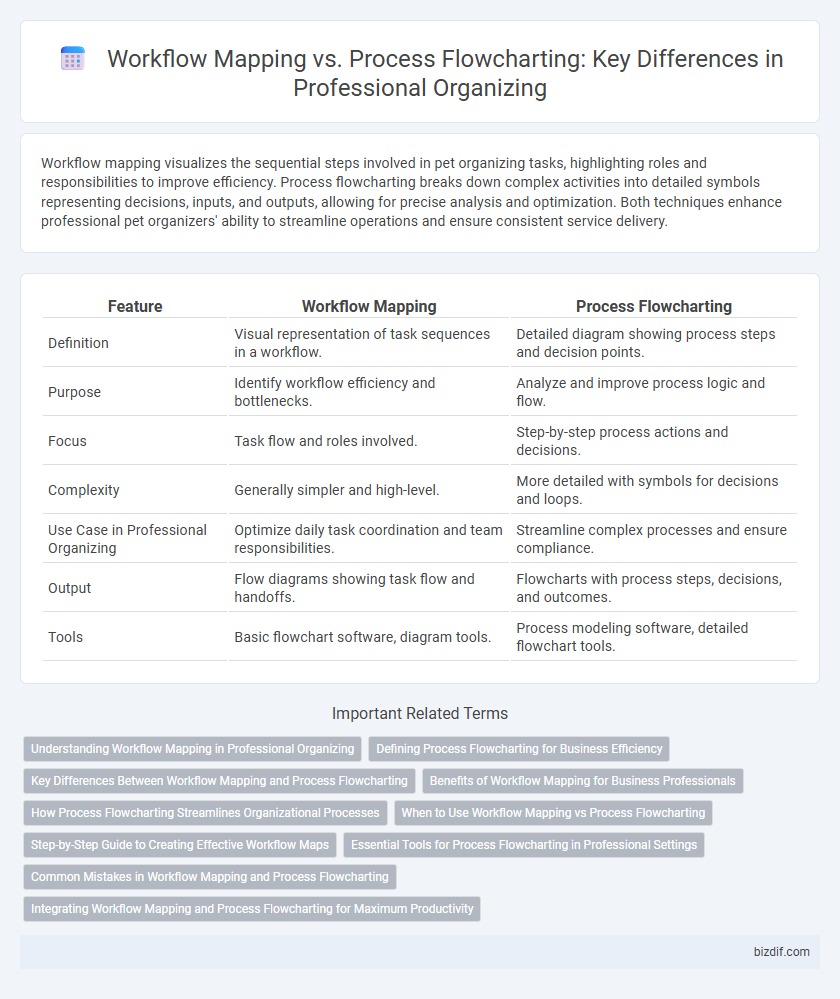Workflow mapping visualizes the sequential steps involved in pet organizing tasks, highlighting roles and responsibilities to improve efficiency. Process flowcharting breaks down complex activities into detailed symbols representing decisions, inputs, and outputs, allowing for precise analysis and optimization. Both techniques enhance professional pet organizers' ability to streamline operations and ensure consistent service delivery.
Table of Comparison
| Feature | Workflow Mapping | Process Flowcharting |
|---|---|---|
| Definition | Visual representation of task sequences in a workflow. | Detailed diagram showing process steps and decision points. |
| Purpose | Identify workflow efficiency and bottlenecks. | Analyze and improve process logic and flow. |
| Focus | Task flow and roles involved. | Step-by-step process actions and decisions. |
| Complexity | Generally simpler and high-level. | More detailed with symbols for decisions and loops. |
| Use Case in Professional Organizing | Optimize daily task coordination and team responsibilities. | Streamline complex processes and ensure compliance. |
| Output | Flow diagrams showing task flow and handoffs. | Flowcharts with process steps, decisions, and outcomes. |
| Tools | Basic flowchart software, diagram tools. | Process modeling software, detailed flowchart tools. |
Understanding Workflow Mapping in Professional Organizing
Workflow mapping in professional organizing visualizes the sequence of tasks and interactions within an organizing project, highlighting roles, resources, and dependencies essential for efficient task completion. Unlike process flowcharting, which emphasizes decision points and process steps, workflow mapping focuses on the holistic view of task coordination and resource allocation to streamline operations. This approach improves project transparency, identifies bottlenecks, and enhances overall productivity in managing organizing workflows.
Defining Process Flowcharting for Business Efficiency
Process flowcharting visually represents business processes through standardized symbols, enabling clear identification of each step and decision point. This technique enhances business efficiency by pinpointing bottlenecks, redundancies, and opportunities for process improvement. Implementing process flowcharts streamlines communication across teams and supports data-driven decision-making in professional organizing workflows.
Key Differences Between Workflow Mapping and Process Flowcharting
Workflow mapping emphasizes the sequence of tasks and responsibilities to optimize efficiency and clarity in professional organizing. Process flowcharting uses standardized symbols to represent decision points and process steps, providing a detailed visual analysis of complex processes. Key differences include workflow mapping's focus on task alignment and collaboration, whereas process flowcharting prioritizes detailed process visualization and troubleshooting.
Benefits of Workflow Mapping for Business Professionals
Workflow mapping enhances clarity by visually illustrating task sequences, enabling business professionals to identify inefficiencies quickly and streamline operations. This method supports cross-functional collaboration by defining roles and responsibilities clearly, reducing errors and improving project outcomes. Improved transparency from workflow mapping leads to better resource allocation, increased productivity, and informed decision-making in business environments.
How Process Flowcharting Streamlines Organizational Processes
Process flowcharting streamlines organizational processes by visually outlining each step in a sequence, enabling teams to identify redundancies and inefficiencies swiftly. This method enhances communication and standardizes procedures across departments, ensuring consistent output and reducing errors. By clarifying roles and decision points, process flowcharting supports effective resource allocation and accelerates workflow optimization.
When to Use Workflow Mapping vs Process Flowcharting
Workflow mapping is ideal for visualizing end-to-end sequences in professional organizing tasks, highlighting roles and responsibilities across multiple steps. Process flowcharting is best used to detail specific tasks, decision points, and actions within a defined segment of the organizing process. Use workflow mapping for strategic overview and coordination, while process flowcharting suits granular analysis and optimization of individual workflows.
Step-by-Step Guide to Creating Effective Workflow Maps
Workflow mapping visually outlines each task in a project, highlighting dependencies and sequences to optimize efficiency, while process flowcharting focuses on detailed decision points within a process. To create effective workflow maps, start by identifying key activities, arranging them in logical order, and using clear symbols to represent tasks and transitions. Incorporating feedback loops and validating maps with team members ensures accuracy and streamlines professional organizing efforts.
Essential Tools for Process Flowcharting in Professional Settings
Essential tools for process flowcharting in professional organizing include flowchart software like Microsoft Visio, Lucidchart, and SmartDraw, which enable precise visualization of workflows. Templates and standardized symbols such as rectangles for tasks, diamonds for decision points, and arrows for process direction enhance clarity and communication. Incorporating these tools streamlines task management, identifies bottlenecks, and improves efficiency in organizational processes.
Common Mistakes in Workflow Mapping and Process Flowcharting
Common mistakes in workflow mapping include oversimplifying tasks and ignoring key stakeholders, which can lead to incomplete process understanding and inefficiencies. In process flowcharting, errors often arise from inconsistent symbol usage and unclear sequencing, causing confusion and misinterpretation among team members. Both techniques require precise detail and collaboration to effectively improve professional organizing systems.
Integrating Workflow Mapping and Process Flowcharting for Maximum Productivity
Integrating workflow mapping and process flowcharting enhances professional organizing by providing a comprehensive visualization of tasks and decision points, enabling clearer identification of bottlenecks and redundancies. Workflow mapping highlights the sequence and movement of work, while process flowcharting details the specific actions and decision logic, combining to streamline operations and improve efficiency. Leveraging both techniques allows organizers to design optimized workflows tailored to unique project demands, driving maximum productivity and effective resource management.
Workflow mapping vs Process flowcharting Infographic

 bizdif.com
bizdif.com